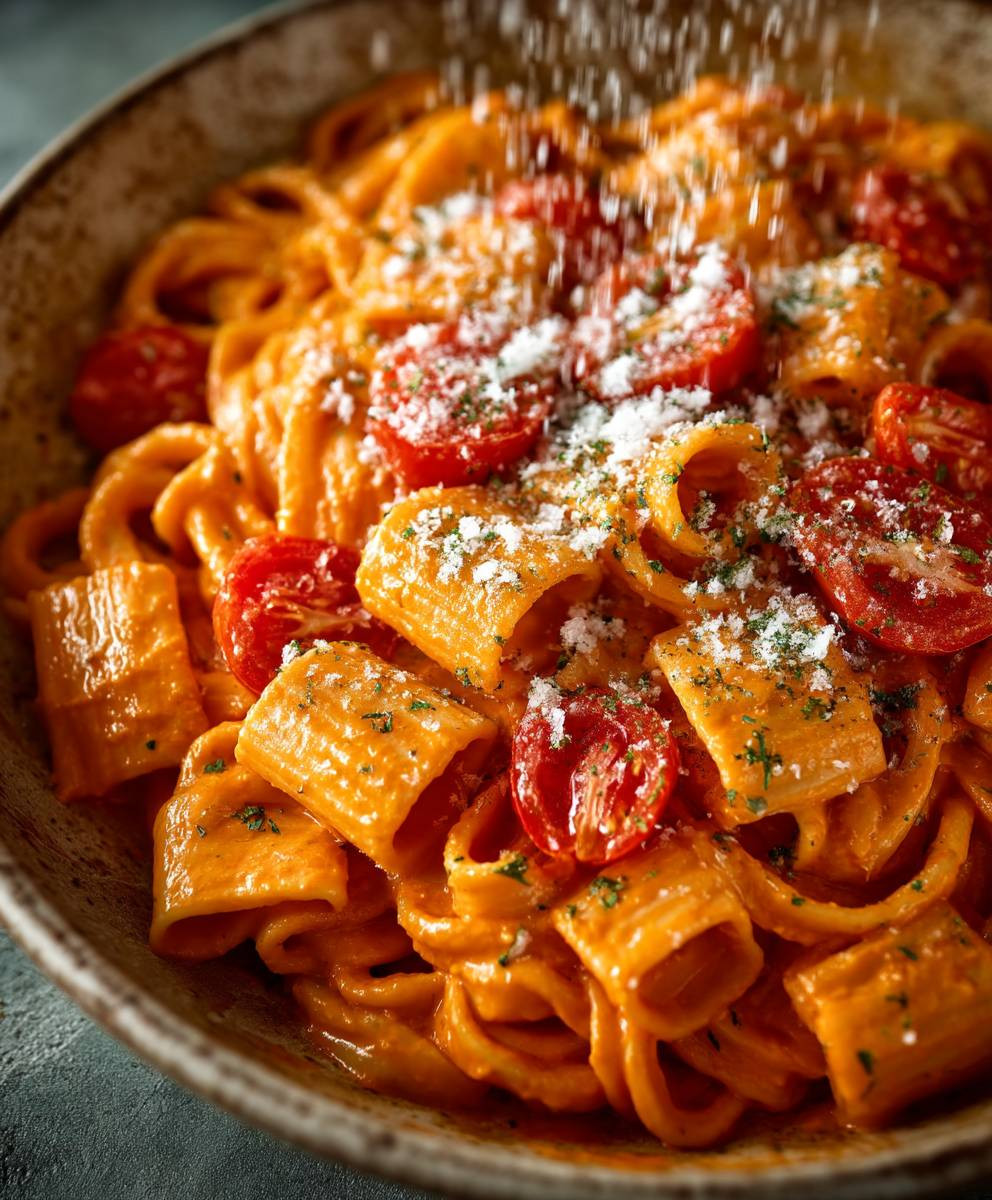Tomato Coconut Pasta Sauce: Prepare to have your pasta nights transformed! Imagine a creamy, vibrant sauce, bursting with the sweetness of ripe tomatoes and the subtle, exotic richness of coconut milk. This isn’t your average marinara; it’s a flavor explosion that will leave you craving more.
While the exact origins of combining tomatoes and coconut milk in pasta sauce are somewhat debated, the fusion likely stems from the beautiful culinary crossroads of Indian and Italian cuisines. Both cultures boast rich tomato-based sauces and a love for creamy textures. The addition of coconut milk brings a unique depth and sweetness that elevates the humble tomato to new heights.
What makes this Tomato Coconut Pasta Sauce so irresistible? It’s the perfect balance of flavors. The acidity of the tomatoes is beautifully tempered by the creamy coconut milk, creating a sauce that’s both comforting and exciting. People adore it because it’s incredibly versatile – perfect for a quick weeknight dinner or a sophisticated meal for guests. Plus, it’s naturally vegan and gluten-free, making it a crowd-pleaser for those with dietary restrictions. Get ready to experience a pasta sauce that’s both delicious and surprisingly easy to make!
Ingredients:
- For the Pasta:
- 1 pound pasta (spaghetti, linguine, or your favorite shape)
- 4 quarts water
- 2 tablespoons salt
- For the Tomato Coconut Sauce:
- 2 tablespoons olive oil
- 1 medium yellow onion, finely chopped
- 2 cloves garlic, minced
- 1 red bell pepper, finely chopped
- 1 (28 ounce) can crushed tomatoes
- 1 (13.5 ounce) can full-fat coconut milk
- 1/2 cup vegetable broth (or water)
- 1 teaspoon dried oregano
- 1/2 teaspoon dried basil
- 1/4 teaspoon red pepper flakes (optional, for heat)
- 1 teaspoon sugar (or honey)
- Salt and freshly ground black pepper to taste
- Optional Garnishes:
- Fresh basil leaves, chopped
- Toasted coconut flakes
- Red pepper flakes
- Grated Parmesan cheese (if not vegan)
Preparing the Tomato Coconut Sauce:
- Sauté the Aromatics: Heat the olive oil in a large, deep skillet or pot over medium heat. Add the chopped onion and cook until softened and translucent, about 5-7 minutes. Stir occasionally to prevent burning. You want the onion to be nice and sweet, so don’t rush this step!
- Add Garlic and Bell Pepper: Add the minced garlic and chopped red bell pepper to the skillet. Cook for another 2-3 minutes, stirring frequently, until the garlic is fragrant and the bell pepper is slightly softened. Be careful not to burn the garlic, as it can become bitter.
- Incorporate the Tomatoes: Pour in the crushed tomatoes and stir to combine. Bring the mixture to a simmer.
- Add Coconut Milk and Broth: Pour in the coconut milk and vegetable broth (or water). Stir well to ensure everything is evenly distributed. The coconut milk will add a lovely creaminess and richness to the sauce.
- Season the Sauce: Add the dried oregano, dried basil, red pepper flakes (if using), and sugar (or honey). Season with salt and freshly ground black pepper to taste. Remember, you can always add more seasoning later, so start with a little and adjust as needed.
- Simmer the Sauce: Reduce the heat to low, cover the skillet or pot, and let the sauce simmer for at least 20-30 minutes, or even longer for a richer flavor. Stir occasionally to prevent sticking. The longer it simmers, the more the flavors will meld together. I often let mine simmer for an hour!
- Taste and Adjust: After simmering, taste the sauce and adjust the seasoning as needed. You might want to add more salt, pepper, red pepper flakes, or even a little more sugar or honey to balance the acidity of the tomatoes.
- Blend for Extra Smoothness (Optional): If you prefer a smoother sauce, you can use an immersion blender to blend the sauce directly in the pot. Alternatively, you can carefully transfer the sauce to a regular blender and blend until smooth. Be cautious when blending hot liquids, and make sure to vent the blender to prevent pressure buildup. I usually skip this step, but it’s a great option if you have picky eaters!
Cooking the Pasta:
- Boil the Water: While the sauce is simmering, bring 4 quarts of water to a rolling boil in a large pot.
- Salt the Water: Add 2 tablespoons of salt to the boiling water. This is important for seasoning the pasta from the inside out. Don’t be afraid of the salt; it really makes a difference!
- Cook the Pasta: Add the pasta to the boiling water and cook according to the package directions, until al dente. Al dente means “to the tooth” in Italian, and it refers to pasta that is firm to the bite.
- Reserve Pasta Water: Before draining the pasta, reserve about 1 cup of the pasta water. This starchy water is a secret weapon for creating a creamy and emulsified sauce.
- Drain the Pasta: Drain the pasta in a colander. Do not rinse the pasta unless you are using it for a cold pasta salad.
Combining Pasta and Sauce:
- Add Pasta to Sauce: Add the drained pasta to the skillet or pot with the tomato coconut sauce.
- Toss to Coat: Toss the pasta and sauce together until the pasta is evenly coated.
- Add Pasta Water (if needed): If the sauce is too thick, add a little of the reserved pasta water, one tablespoon at a time, until the sauce reaches your desired consistency. The pasta water will help to create a creamy and emulsified sauce that clings to the pasta.
- Heat Through: Cook for another minute or two, stirring constantly, until the pasta is heated through.
Serving and Garnishing:
- Serve Immediately: Serve the tomato coconut pasta immediately.
- Garnish (Optional): Garnish with fresh basil leaves, toasted coconut flakes, red pepper flakes, and grated Parmesan cheese (if not vegan). These garnishes add flavor, texture, and visual appeal to the dish.
- Enjoy! Enjoy your delicious and flavorful tomato coconut pasta!
Tips and Variations:
- Add Protein: For a heartier meal, add protein such as grilled chicken, shrimp, tofu, or chickpeas to the sauce.
- Spice it Up: If you like a spicier sauce, add more red pepper flakes or a pinch of cayenne pepper.
- Add Vegetables: Feel free to add other vegetables to the sauce, such as spinach, kale, zucchini, or mushrooms.
- Make it Vegan: This recipe is naturally vegan if you omit the Parmesan cheese garnish.
- Use Different Pasta: Experiment with different types of pasta, such as penne, rigatoni, or farfalle.
- Make it Ahead: The tomato coconut sauce can be made ahead of time and stored in the refrigerator for up to 3 days. Simply reheat the sauce before adding the cooked pasta.
- Freezing: The sauce can also be frozen for up to 2 months. Thaw it overnight in the refrigerator before reheating.
- Fresh Herbs: While dried herbs work well, using fresh oregano and basil will elevate the flavor even further. Add them towards the end of the simmering process to preserve their freshness.
- Lemon Juice: A squeeze of fresh lemon juice at the end can brighten up the flavors of the sauce.
- Sun-Dried Tomatoes: Add a handful of chopped sun-dried tomatoes for an intense burst of tomato flavor.
- Nutritional Yeast: For a cheesy flavor without the dairy, add a tablespoon or two of nutritional yeast to the sauce.
- Ginger and Turmeric: For an interesting twist, add a small amount of grated ginger and turmeric to the sauce while sautéing the aromatics. This will add warmth and complexity to the flavor profile.
- Roasting the Vegetables: Roasting the onion, garlic, and bell pepper before adding them to the sauce can enhance their sweetness and depth of flavor. Toss them with olive oil, salt, and pepper, and roast at 400°F (200°C) until tender and slightly caramelized.
- Using Fresh Tomatoes: If you have fresh tomatoes on hand, you can use them instead of canned crushed tomatoes. You’ll need about 2 pounds of fresh tomatoes. Peel and chop them before adding them to the sauce. You may need to simmer the sauce for a longer time to reduce the liquid.
Enjoy your culinary creation!

Conclusion:
This Tomato Coconut Pasta Sauce isn’t just another pasta sauce recipe; it’s a flavor explosion waiting to happen in your kitchen! I truly believe this is a must-try because it perfectly balances the acidity of ripe tomatoes with the creamy sweetness of coconut milk, creating a symphony of taste that will tantalize your taste buds. It’s surprisingly easy to make, requiring minimal effort for maximum flavor payoff. Forget those bland, store-bought sauces – this homemade version is fresher, healthier, and infinitely more satisfying.
But the best part? It’s incredibly versatile! While I adore it tossed with classic spaghetti or penne, don’t be afraid to experiment. For a heartier meal, try it with rigatoni or even stuffed shells. If you’re looking for a lighter option, zucchini noodles or spaghetti squash work beautifully. And for a protein boost, consider adding grilled chicken, shrimp, or even some crumbled Italian sausage directly to the sauce.
Speaking of variations, the possibilities are endless! If you like a little heat, add a pinch of red pepper flakes or a finely chopped chili pepper to the sauce while it’s simmering. For a richer, more decadent flavor, stir in a tablespoon of mascarpone cheese or heavy cream just before serving. And if you’re a fan of herbs, fresh basil, oregano, or thyme would all be fantastic additions. You could even roast the tomatoes before blending them for an even deeper, more concentrated flavor. Think of this recipe as a blank canvas – feel free to get creative and tailor it to your own personal preferences.
Beyond pasta, this sauce is also incredible as a base for pizza, a dipping sauce for mozzarella sticks, or even as a flavorful addition to vegetable dishes. I’ve even used it as a braising liquid for chicken, resulting in incredibly tender and flavorful meat. The coconut milk adds a subtle sweetness and richness that elevates any dish it touches.
I’m so confident that you’ll love this Tomato Coconut Pasta Sauce that I urge you to give it a try. It’s the perfect weeknight meal, impressive enough for guests, and a guaranteed crowd-pleaser. Plus, it’s a fantastic way to use up those ripe tomatoes from your garden or the farmer’s market.
Once you’ve made it, I’d absolutely love to hear about your experience! Did you stick to the original recipe, or did you try any variations? What did you serve it with? What did your family and friends think? Share your photos and stories in the comments below – I can’t wait to see what you create! Your feedback is invaluable and helps me continue to improve and share delicious recipes with the world. So, go ahead, grab your ingredients, and get cooking! I promise, you won’t be disappointed. Happy cooking!
Tomato Coconut Pasta Sauce: A Delicious & Easy Recipe
Creamy and flavorful Tomato Coconut Pasta! This easy recipe combines a rich tomato sauce with coconut milk for a delicious vegan (or vegetarian) meal. Ready in under an hour!
Ingredients
- 1 pound pasta (spaghetti, linguine, or your favorite shape)
- 4 quarts water
- 2 tablespoons salt
- 2 tablespoons olive oil
- 1 medium yellow onion, finely chopped
- 2 cloves garlic, minced
- 1 red bell pepper, finely chopped
- 1 (28 ounce) can crushed tomatoes
- 1 (13.5 ounce) can full-fat coconut milk
- 1/2 cup vegetable broth (or water)
- 1 teaspoon dried oregano
- 1/2 teaspoon dried basil
- 1/4 teaspoon red pepper flakes (optional, for heat)
- 1 teaspoon sugar (or honey)
- Salt and freshly ground black pepper to taste
- Fresh basil leaves, chopped
- Toasted coconut flakes
- Red pepper flakes
- Grated Parmesan cheese (if not vegan)
Instructions
- Heat the olive oil in a large, deep skillet or pot over medium heat. Add the chopped onion and cook until softened and translucent, about 5-7 minutes. Stir occasionally to prevent burning.
- Add the minced garlic and chopped red bell pepper to the skillet. Cook for another 2-3 minutes, stirring frequently, until the garlic is fragrant and the bell pepper is slightly softened.
- Pour in the crushed tomatoes and stir to combine. Bring the mixture to a simmer.
- Pour in the coconut milk and vegetable broth (or water). Stir well to ensure everything is evenly distributed.
- Add the dried oregano, dried basil, red pepper flakes (if using), and sugar (or honey). Season with salt and freshly ground black pepper to taste.
- Reduce the heat to low, cover the skillet or pot, and let the sauce simmer for at least 20-30 minutes, or even longer for a richer flavor. Stir occasionally to prevent sticking.
- After simmering, taste the sauce and adjust the seasoning as needed.
- If you prefer a smoother sauce, you can use an immersion blender to blend the sauce directly in the pot. Alternatively, you can carefully transfer the sauce to a regular blender and blend until smooth. Be cautious when blending hot liquids, and make sure to vent the blender to prevent pressure buildup.
- While the sauce is simmering, bring 4 quarts of water to a rolling boil in a large pot.
- Add 2 tablespoons of salt to the boiling water.
- Add the pasta to the boiling water and cook according to the package directions, until al dente.
- Before draining the pasta, reserve about 1 cup of the pasta water.
- Drain the pasta in a colander. Do not rinse the pasta unless you are using it for a cold pasta salad.
- Add the drained pasta to the skillet or pot with the tomato coconut sauce.
- Toss the pasta and sauce together until the pasta is evenly coated.
- If the sauce is too thick, add a little of the reserved pasta water, one tablespoon at a time, until the sauce reaches your desired consistency.
- Cook for another minute or two, stirring constantly, until the pasta is heated through.
- Serve the tomato coconut pasta immediately.
- Garnish with fresh basil leaves, toasted coconut flakes, red pepper flakes, and grated Parmesan cheese (if not vegan).
- Enjoy!
Notes
- Add Protein: For a heartier meal, add protein such as grilled chicken, shrimp, tofu, or chickpeas to the sauce.
- Spice it Up: If you like a spicier sauce, add more red pepper flakes or a pinch of cayenne pepper.
- Add Vegetables: Feel free to add other vegetables to the sauce, such as spinach, kale, zucchini, or mushrooms.
- Make it Vegan: This recipe is naturally vegan if you omit the Parmesan cheese garnish.
- Use Different Pasta: Experiment with different types of pasta, such as penne, rigatoni, or farfalle.
- Make it Ahead: The tomato coconut sauce can be made ahead of time and stored in the refrigerator for up to 3 days. Simply reheat the sauce before adding the cooked pasta.
- Freezing: The sauce can also be frozen for up to 2 months. Thaw it overnight in the refrigerator before reheating.
- Fresh Herbs: While dried herbs work well, using fresh oregano and basil will elevate the flavor even further. Add them towards the end of the simmering process to preserve their freshness.
- Lemon Juice: A squeeze of fresh lemon juice at the end can brighten up the flavors of the sauce.
- Sun-Dried Tomatoes: Add a handful of chopped sun-dried tomatoes for an intense burst of tomato flavor.
- Nutritional Yeast: For a cheesy flavor without the dairy, add a tablespoon or two of nutritional yeast to the sauce.
- Ginger and Turmeric: For an interesting twist, add a small amount of grated ginger and turmeric to the sauce while sautéing the aromatics. This will add warmth and complexity to the flavor profile.
- Roasting the Vegetables: Roasting the onion, garlic, and bell pepper before adding them to the sauce can enhance their sweetness and depth of flavor. Toss them with olive oil, salt, and pepper, and roast at 400°F (200°C) until tender and slightly caramelized.
- Using Fresh Tomatoes: If you have fresh tomatoes on hand, you can use them instead of canned crushed tomatoes. You’ll need about 2 pounds of fresh tomatoes. Peel and chop them before adding them to the sauce. You may need to simmer the sauce for a longer time to reduce the liquid.




